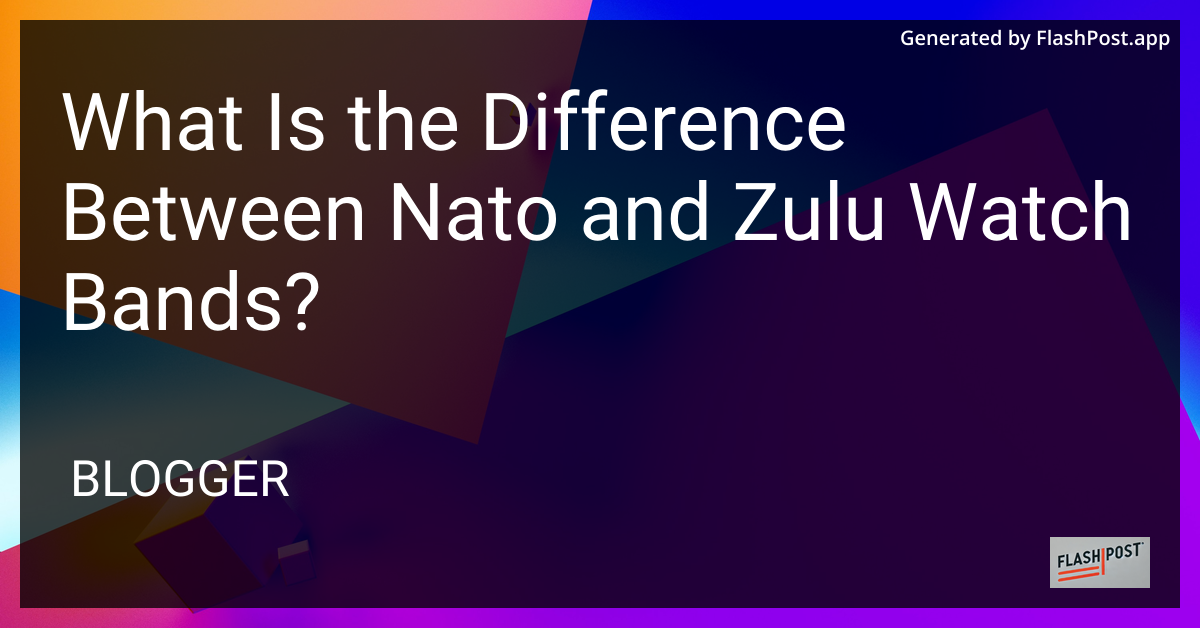What Is the Difference Between Nato and Zulu Watch Bands?

The Difference Between NATO and Zulu Watch Bands: A Comprehensive Guide
When diving into the world of watch bands, two terms frequently arise: NATO and Zulu watch bands. Both are popular among watch enthusiasts and adventurers, but what sets them apart? Understanding the differences can not only help refine your style but also ensure the comfort and functionality of your watch wear. In this article, we’ll break down the key differences between NATO and Zulu watch bands to help you make an informed choice.
What Are NATO Watch Bands?
NATO watch bands have a rich history, originally developed by the British Ministry of Defence in 1973 under the official name “G10”. It quickly became known as the NATO strap due to its NATO stock number. These bands are crafted from nylon, which makes them lightweight yet durable.
Key Features of NATO Bands:
- Material: Typically made from nylon, known for its array of color options.
- Design: Features a singular piece of nylon that threads through the watch and under the case, offering additional security.
- Buckle System: Comes with a unique additional strap and buckle system to prevent the watch from detaching.
- Versatility: Their design makes them easy to swap out, fitting a wide range of wrist sizes.
What Are Zulu Watch Bands?
Zulu watch bands are similar in appearance to NATO straps but with distinct variations that set them apart. They are often hailed for their larger hardware and are widely used in adventure and tactical scenarios.
Key Features of Zulu Bands:
- Material: Also made from nylon, but can sometimes be found in thicker variations.
- Design: Zulu bands usually involve a heavier, rounder, and more robust set of hardware.
- Buckle System: Often come with a single piece of strong, sturdy ring.
- Durability: Known for their thicker build and strong presence, making them ideal for rugged use.
Key Differences Between NATO and Zulu Straps
- Hardware: NATO bands have smaller, more intricate buckles, while Zulu bands boast larger, rounder hardware.
- Durability: Zulu straps tend to be thicker, which not only enhances their durability but also makes them slightly heavier.
- Appearance: NATO straps typically offer a finer, more refined appearance owing to their slimmer hardware, whereas Zulu straps have a more rugged, robust look.
- Versatility: While both are versatile, NATO straps are often preferred for civilian and formal wear due to their sleeker design, whereas Zulu bands are favored for outdoor and tactical use.
Conclusion: Which One is Right for You?
Choosing between a NATO and a Zulu watch band ultimately boils down to personal style preference and functional need. If you desire a strap that’s sleek and easy to pair with various outfits, a NATO strap might be your best bet. For those needing something stronger for rugged activities, the Zulu band could be more suitable. Whichever you choose, both options are excellent for enhancing your watch’s style and functionality.
For those exploring watch accessories, don’t miss out on the best Apple Watch band deals for 2025 to ensure you’re getting high-quality bands at the best prices.
”` This markdown article incorporates an informative breakdown of the differences between NATO and Zulu watch bands, ensuring that the content is optimized not only for SEO but also for readers interested in watch accessories. The included image and link to a related article enhance the value and usability of the piece.
Comments
Post a Comment